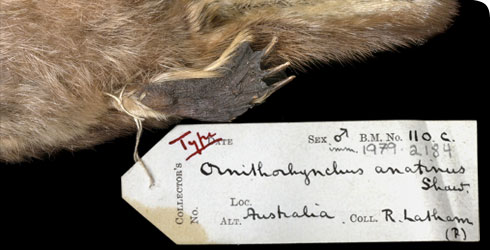Taxonomy
The platypus was described scientifically for the first time by Dr George Shaw (1751-1813), who named it Platypus anatinus. Platypus is an anglicised Greek word meaning flat foot, probably referring to the web on its feet.
Unfortunately this name had already been applied to a genus of beetles, so it had to be changed. Ornithorhynchus (bird-snout) replaced it, but the species name anatinus (duck-like) remained the same.
The original specimen described by Shaw is currently stored with our research collections.
Morphology
No other animal on Earth looks quite like the platypus. The most distinctive feature is the bill, which is not hard like the bill of a duck but soft and pliable. It is well supplied with nerves and is used by the animal to locate food and to find its way around under water.
Platypuses lose their deciduous juvenile teeth a short time after the young leave the nesting burrows. They are replaced by horny pads made of keratin.
Built for swimming and digging
Platypuses are covered with dense, waterproof fur, except on their feet and bill.
They have a streamlined shape, short limbs and propels themselves through the water using alternate kicks of their webbed front limbs. These webs of the forefeet are folded back when the animal is walking or burrowing to expose strong claws.
Behind the bill on either side of the head are 2 grooves that house the ear openings and the eyes which close when the platypus dives. The nostrils are on top of the bill, not far back from the tip.
The skeleton is streamlined but heavy enough to support large muscles for swimming and digging.
Other key features
Each of the males’ rear legs bears a horny spur on the ankle of about 1.5cm in length. This hollow spur is connected to a venom gland in the upper leg.
The tail consists mainly of fatty tissue and acts as a fat storage area.
Interestingly, the platypus skeleton shows reptilian and marsupial features:
- Between the collar bone and the sternum the platypus has a distinctively T-shape bone called the interclavicle, which is also found in modern reptiles.
- Like marsupials, the platypus has two epipubic bones attached to its pelvic girdle.
- The legs are splayed rather like those of reptiles but they rotate in their sockets like those of mammals. (Grant, 2007)
-
Evolution and genetics
The mixture of both reptilian and mammalian characteristics exhibited by Ornithorhynchus anatinus extends to its genome sequence. Find out more about this species' evolution and genetics.
